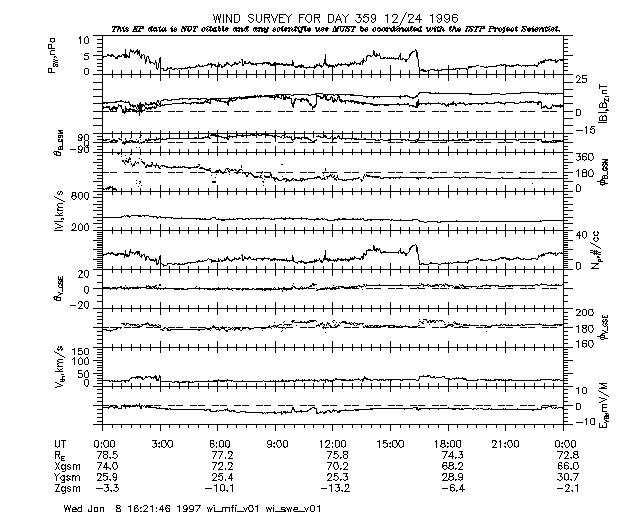
This description is not meant to pass as true science, but rather as an example of how on-line data can be used to gauge the solar climate during a suspected event. The on-line data can be accessed rapidly, and it is possible to undertake a minor investigation of an event in a few minutes. The data on this page was accumulated entirely during the "Multipoint Observations of the Solar Wind" session, through a WWW connection in the meeting room. The EIT movies were generated during the workshop, by an EIT team member.
During the workshop, Len Burlaga and Adam Szabo indicated that there was a possible magnetic cloud event observed on 24 Dec 1996. The WIND data are available at the ISTP Science Planning and Operations Facility (SPOF) site, which can produce plots of ISTP Key Parameter data.
The on-line WIND data produced by SPOF included magnetic field magnitude, and direction, dynamic pressure, plasma bulk speed, and proton density:

WIND and SOHO's locations were found using the CDAWeb (Coordinated Data Analysis) Space Physics Public Database, which can generate plots of the orbits of both spacecraft. Judging from the solar wind speed of 400 km/sec, it was estimated that the event would have taken 4.2 days to reach L1. SOHO Celias data from the MTOF Proton Monitor was consulted, and the EIT images and MDI magnetograms were retrieved using the SOHO Summary Data Base:
The first magnetogram was taken on 18 December at 19:04 UT, the second on 19 December at 20:32, and the third on 20 December at 17:57 UT. Several regions of high magnetic activity were located near the meridian; if the event is linked to a region of high magnetic activity, the regions nearest disk center are the most suspect.
The EIT images from the SOHO Summary Data Base showed the activity associated with the magnetic footpoints, particularly in the case of the iron lines, Fe IX/X (171 Å, blue images), Fe XII (195 Å, green images), and Fe XV (284 Å, yellow images):
The He II (304 Å, orange) images indicated that there may be filaments (which could possibly erupt) on the disk. Thus, the next investigation was through the SOHO Synoptic Data Base to gather ground-based H alpha images, which may provide further evidence of evolving filaments on the disk. The first image was generated by the National Solar Observatory at Sacramento Peak, and the second and third are from the Big Bear Solar Observatory at Caltech.
We then checked the LASCO Coronal Mass Ejection List, and the SOHO Summary Data Base to view the LASCO C1 Coronagraph Images. The event list indicated that several CME events occurred between the 18th and 20th of December, including a halo-type CME on the 19th at 17:40 UT. The database returned the following images from the C1 coronagraph (C2 and C3 images are difficult to interpret without the calibration software):
Finally, EIT movies were made of the events (warning: they're big! 2 megabytes after being reduced to 1/4 resolution and bytescaled):
Note that the two active regions nearest the center appear to be connected by their activity, and that the 195 Å movie contains a phenomenal amount of variation. The activity in the EIT 195 and 284 Å movies indicated that the Yohkoh SXT (Soft X-ray Telescope) images from those dates might reveal activity at even higher temperatures. We returned to the SOHO Synoptic Data Base for the following movie:
This GOES 3-day plot of soft X-ray flux, which was obtained through the NOAA Space Environment Lab's Gopher Server, indicates a lot of X-ray activity on the 19th of December:
![]()
![]()
This page was created 6 January 1997.
This page was revised on 12 January 1997.
Barbara J. Thompson